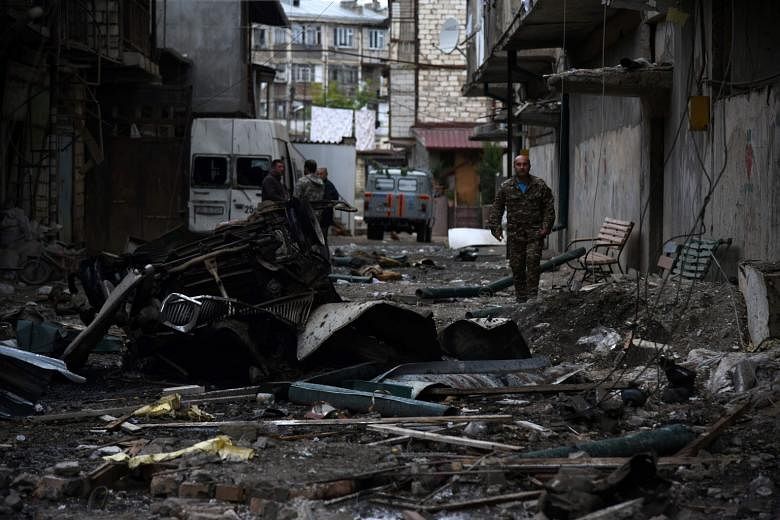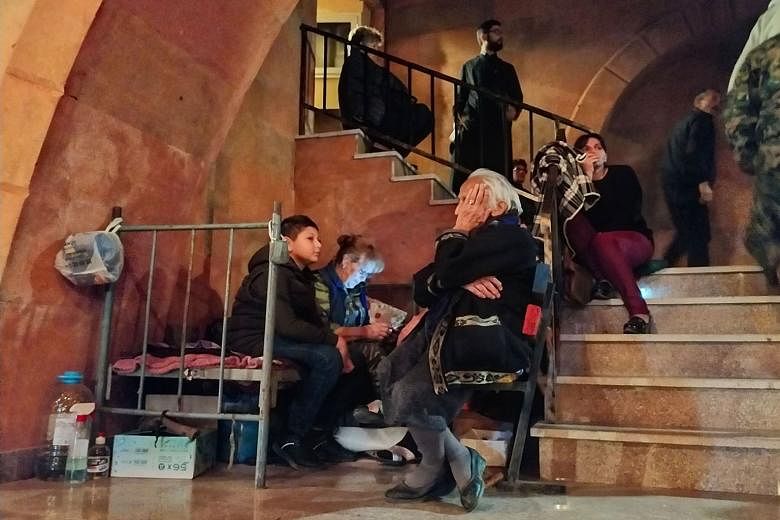STEPANAKERT (Azerbaijan) • A candle lights the strained faces of civilians huddled in the basement of the Holy Mother of God Cathedral in Nagorno-Karabakh's main city Stepanakert, where they have sought refuge from fighting that erupted a week ago over the disputed region.
Sunday starts quietly, but soon there are air raid sirens breaking the silence.
For the people who live near the cathedral affiliated with the Armenian Apostolic Church, it is the ideal shelter.
"It is probably the safest place in Stepanakert, protected by the granite and by Our Lord," said a burly priest, wearing a black robe and camouflage vest.
He is calm as he organises space for the refugees, hampered by frequent power cuts.
The vast underground hall is ringed by chapels serving as temporary homes for families grouped around mattresses covered with thick, multi-coloured blankets.
"We've been here three days," murmured Ms Gohar, holding one-year-old Angelina in her arms.
Women of all ages try to help the children pass the time.
"The men are at the front," Ms Gohar said before sobbing: "I learnt yesterday that a friend of mine who was 23 had died."
She has had no news of her brother, who joined in the new fighting, the heaviest in decades that has so far claimed nearly 250 lives, including nearly 40 civilians.
Ms Gohar is not prepared to flee Karabakh, the homeland she refers to by its Armenian name, Artsakh. "We just hope that all this will end in a few days."
But several families left last Saturday for the Armenian capital Yerevan.
Some of the refugees leave the sanctuary during lulls in the fighting or under cover of darkness to go home to collect food or clothing. Food is in abundant supply, however, donated in Yerevan and taken to Stepanakert by volunteers, associations or just concerned individuals.
No mass was celebrated this Sunday given the fraught climate, though a few faithful chanted brief prayers in the nave, facing banks of empty pews.
An elderly woman wearing a black veil could be seen reciting the rosary before bowing to an icon in a cloud of incense.
A group of men, some in uniform, wait under the portico before the cathedral's sculpted wooden doors, scanning the clouds and discussing the latest from the front.
"We will never let the enemy get in very deep," said one of the priests, holding a gold crucifix. "We are here on the historical land of Armenian Christianity."
The air raid sirens sound once more, first far off, then closer. Everyone scrambles inside and down to the basement.
A minute later, explosions ring out. Grey smoke rises from buildings in the distance.
"Those are Grads," said one man, referring to a truck-mounted rocket launcher. He is a veteran of the conflict that first broke out in 1988 and claimed some 30,000 lives.
AGENCE FRANCE-PRESSE


